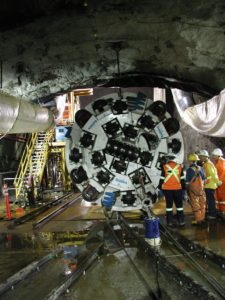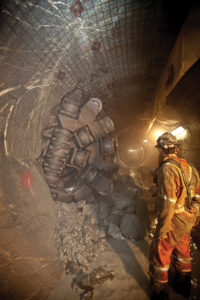![65 Years of Innovation and Experience [default]](https://www.robbinstbm.com/wp-content/uploads/2017/04/Side-Bar-Blue-Blocks_70-Years.jpg)
A Solution for Every Condition: Search our Project Database
Project Map
FEATURED PRODUCT: CROSSOVER MACHINES
Our History
A Legacy of Innovation
Information 24/7
News & Media
Insights in the Industry:
Read the Robbins Blog
 The Seymour-Capilano Water Filtration Project seeks to improve the filtration of drinking water in Vancouver, British Columbia. The completed filtration system will clean 1.8 billion liters (475.5 million gallons) of water a day and will lower the water turbidity (cloudiness) and micro-organism levels to meet federal standards for drinking water.
The Seymour-Capilano Water Filtration Project seeks to improve the filtration of drinking water in Vancouver, British Columbia. The completed filtration system will clean 1.8 billion liters (475.5 million gallons) of water a day and will lower the water turbidity (cloudiness) and micro-organism levels to meet federal standards for drinking water.
The project calls for twin tunnels, each 7.2 km (4.5 mi) long. The tunnels will transport untreated water from the Capilano reservoir to a filtration plant in the Lower Seymour Conservation Reserve and will return treated water to the Capilano reservoir for public consumption.
In 2004, the project owner, Greater Vancouver Regional District, awarded the construction contract to Germany-based Bilfinger Berger. The contractor chose two 3.8 m (12.5 ft) diameter Main Beam Robbins TBMs to bore the tunnels in intrusive granitic rock with strengths of 200 – 265 MPa (29 – 38 ksi).
Each TBM is outfitted with probe drills, to be used for the entire length of the tunnels. The probe drills probe ahead 40 m to check for pockets of underground water and verify the geology. The tunnel is unlined during excavation, but each machine is equipped with a ring beam erector to install full or partial beams depending on the geology.
 The first of the two TBMs was delivered on May 18, 2006 and began boring on July 1, 2006. The second Robbins TBM was launched from the same shaft. Both machines were assembled in very short (60.5m/200ft and 70.5 m/230 ft) starter tunnels at the bottom of the 180 m (591 ft) shaft. Because of the short tunnel lengths, both TBMs excavated with their back-up systems partially constructed until they bored ahead 200 m (650 ft). The TBMs were assembled with only 11 decks of their respective 35 deck back-up systems.
The first of the two TBMs was delivered on May 18, 2006 and began boring on July 1, 2006. The second Robbins TBM was launched from the same shaft. Both machines were assembled in very short (60.5m/200ft and 70.5 m/230 ft) starter tunnels at the bottom of the 180 m (591 ft) shaft. Because of the short tunnel lengths, both TBMs excavated with their back-up systems partially constructed until they bored ahead 200 m (650 ft). The TBMs were assembled with only 11 decks of their respective 35 deck back-up systems.
After difficult ground conditions halted both TBMs for more than a year, excavation restarted in April 2009. New contractor, Frontier-Kemper/J.F. Shea/Aecon, restarted the machines and achieved advance rates of up to 29 m (95 ft) per day.
On November 4, 2010, the final breakthrough for the second of two Robbins TBMs capped more than two years of hard rock tunneling over a four year period. Frontier-Kemper successfully dealt with rocky conditions and some faulting using a program of rock bolts, wire mesh, and steel sets. Rock support varies from bare rock in good ground (Class I), to steel sets every 760 mm (30 in) in Class V poor rock.
The second Robbins TBM holed through at an angle into the other tunnel, where a chamber will now be built to conduct raise drilling of the 270 m (885 ft) deep Capilano shaft.

 Close
Close